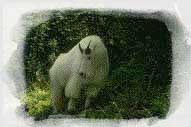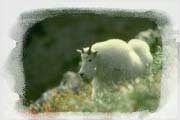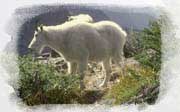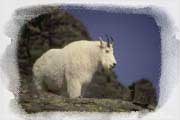
Mountain goats are not really goats at all, but are members of the antelope family. Mountain goats (Oreamnos americanus) are native to Alaska, the Cascade Mountains of Washington State, and a few other areas in the lower 48 states. Much of Washington's mountain goat habitat is on federally managed land (national parks and forests). Mountain goats are specialized in their hoof and body shape so that they can be the most successful travelers on the cliffs where few predators will follow. To survive in such a specialized habitat, however, they are generalist herbivores who are able to eat most plants, including lichens. mosses, and conifers. They live at a variety of elevations, near different forest types, but always near cliffs. 
In winter, bands of goats move down to lower-elevation. south-facing old growth forests that are interspersed with rocky outcrops where they gain some protection from harsh winter elements. The warmer southern exposure and brisk valley winds keep these ledges free of snow, allowing the goats to forage for lichen, grasses and shrubs on snowfree bluffs. Because the best wintering areas are selected for their physical characteristics, and not for the availability of forage, food may be scarce. 
Male and female mountain goats look similar, with shaggy white coats and curved black horns. They live in loose family groups of several adult females (nannies), with their kids and yearlings. Adult males (billies) may be tolerated in the summer, when food is plentiful, and during the autumn mating season. However, during the harsh winter months, the dominant nannies get the best wintering areas. Survival in high alpine regions is a struggle. Mortality rates average 60-70 percent in the first year and 50 percent during the second year of life. Causes of high mortality include avalanches, falls, predation (cougar, golden eagles), parasites, and poor winter conditions causing stress. Mountain goats are mature in 2.5 years and live about 10 years in the wild. Because of their life history characteristics, mountain goats are more vulnerable to population reductions than most ungulate species; it's harder for them to bounce back. Human presence can adversely affect mountain goats by causing them to use energy they would otherwise use to survive. Please keep a polite distance from any mountain goats you see and then come tell us about your experience! 
This research helps resource managers assess potential impacts on mountain goats when evaluating proposed projects in the park such as trail construction and other development. Visitor reports are invaluable and are greatly appreciated. Report mountain goat and other unique wildlife sightings to park staff.
Additional Reading A Beast the Color of Winter: The Mountain Goat Observed, Chadwick, Sierra Club Books. Disclaimer: This book is listed as an example of titles available on this subject. Its listing does not indicate endorsement by the National Park Service. |
An official website of the United States government
Here's how you know
Official websites use .gov
A
.gov website belongs to an official government
organization in the United States.
Secure .gov websites use HTTPS
A
lock (
) or https:// means you've safely connected to
the .gov website. Share sensitive information only on official,
secure websites.
